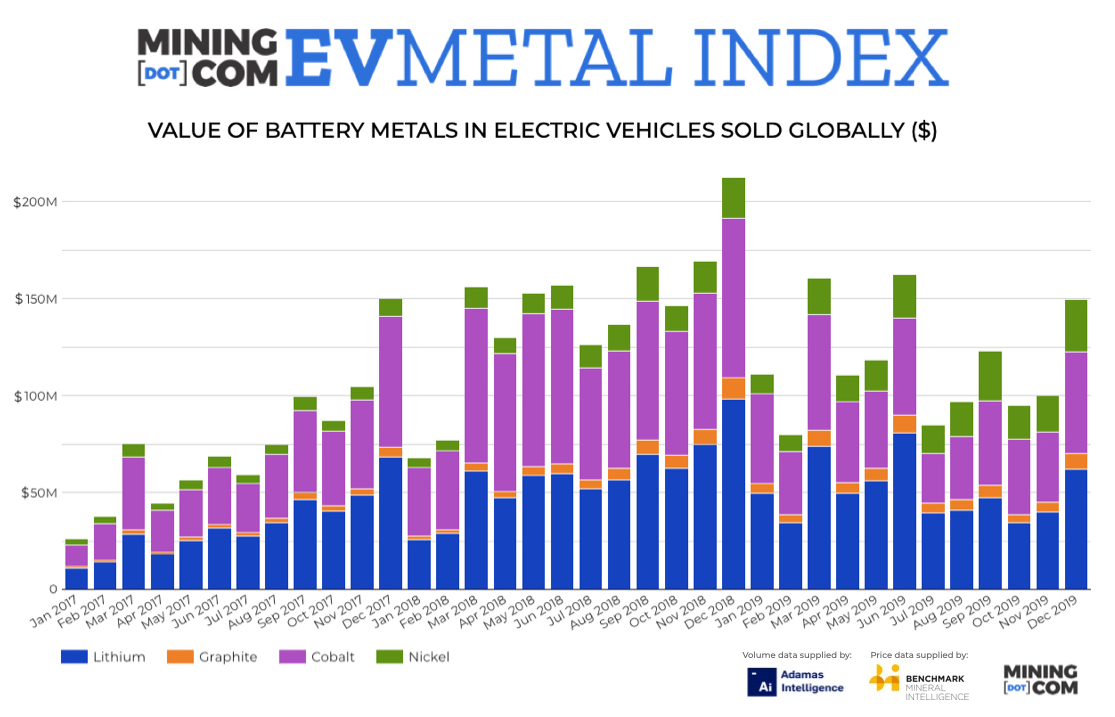SPONSOR: Lomiko Metals is focused on the exploration and development of minerals for the new green economy such as lithium and graphite. Lomiko owns 80% of the high-grade La Loutre graphite Property, Lac Des Iles Graphite Property and the 100% owned Quatre Milles Graphite Property. Lomiko is uniquely poised to supply the growing EV battery market. Click Here For More Information

- Globally, by 2025, Audi is aiming to have 30 electrified models on sale, with 20 of those vehicles fully electric.
- It is an ambitious plan showing the brand’s global commitment for a more electrified and sustainable future.
Already in the U.S., Audi has introduced five production models—the Audi Q5 TFSI e, A7 TFSI e and A8 TFSI e plug-in hybrid electric vehicles (PHEV) as well as the e-tron all-electric SUV and upcoming e-tron Sportback. Next, we’ll introduce the Audi Q4 e-tron SUV and e-tron GT performance sedan, which have already been shown as concept vehicles.
Audi’s upcoming all-electric vehicles will be built on four distinct platforms that balance performance, efficiency, practicality and the engineering and craftsmanship synonymous with the Audi brand. Here are details of the four architectures that will underpin cars and SUVs in a multitude of sizes to bring Audi’s electrified plans to reality.
MLB evo: The first Audi electric vehicles
The first Audi quattro model of the 1980s was simply named “quattro†for its innovative all-wheel-drive technology. Much the same, the “e-tron†name foreshadows a range of electric vehicle (EV) drivetrain technology for the Audi brand. The Audi e-tron SUV is the first all-electric SUV, having gone on sale in the U.S. starting in May 2019. It combines electric mobility with Audi quality: A sophisticated drive and recuperation system, all-wheel drive and maximum comfort. It is an Audi, through and through, in quality, performance and execution.
Manufactured in a certified CO2-neutral plant in Brussels, Belgium, whose 398,264 sq ft rooftop solar array is large enough to produce approximately 3,000 MWh annually—or enough to charge approximately 30,000 e-tron SUVs—the e-tron is based on a heavily modified version of the modular longitudinal platform (MLB evo) that underpins an array of Audi vehicles. With a wheelbase that stretches 115.3 inches, the e-tron is between the Audi Q5 and Audi Q7 SUVs in terms of size, or about the same size as an Audi Q8. The high-voltage battery stores up to 95 kWh of energy and can recover up to 30% of energy used to drive the vehicle during regenerative braking applications. In most applications, the e-tron uses brake-energy regeneration relying on its hydraulic brake booster. A brake pedal simulator makes the switch from regen to hydraulic braking nearly unnoticeable.
The e-tron houses two asynchronous electric motors (ASM) that produce up to 402 horsepower in boost mode. A more powerful, three-motor variant with fully independent rear torque vectoring is also under development.
Using an Audi-designed power electronics module, the e-tron is able to read sensor data 10,000 times per second and output current values for the electric motors to help with traction in various conditions. With its rear-biased quattro all-wheel-drive system, if the e-tron senses a loss of traction, it is able to redistribute torque to wheels with traction in just 30 milliseconds.
The Audi e-tron can charge using both alternating (Level 1 and 2) and direct (Level 3) current and can achieve approximately 80% charge in 30 minutes at a 150 kW high-speed public charger. Later in 2020, the e-tron will be joined by the e-tron Sportback, a new variant with a coupe-like profile.
J1: The performance electric platform
Shown as a concept vehicle thus far, the Audi e-tron GT performance sedan shows how sports cars will evolve in the electric era. For the e-tron GT, Audi is sharing synergies with the Porsche brand, which developed the J1 architecture.
The Audi e-tron GT concept car is equipped with two permanently excited synchronous motors (PSM) that produce a combined 582 horsepower and 612 lb-ft of torque. A PSM has a rotor with permanent magnets in it and a natural internal magnetic field. In a PSM, the rotor moves in coordination with the magnetic field of the stator (the stationary part of the motor in which the rotor rotates), which is why it is known as a permanently excited synchronous motor. By comparison, an asynchronous motor’s rotor rotates slower than a synchronous speed.
While specifications for the e-tron GT are subject to change, the e-tron GT concept is estimated to reach 62 mph from standstill in 3.5 seconds and 124 mph in just over 12 seconds in production form.
The electrical system in the e-tron GT concept car runs at 800 volts, whereas most modern EVs currently operate at a capacity of 400 volts or less. Volts are a measurement of pressure in an electric circuit, and the J1 platform can accept this level of force thanks to its energy management and cooling systems. Because of this, the e-tron GT is able to charge the battery to 80% in about 20 minutes at a Level 3 DC fast charger with a maximum output of 350 kW.
In the e-tron GT, the battery is located in the underbody, between the axles and is designed with recesses in the rear footwell, ensuring comfort for front- and rear-seat passengers. The body and roof of the e-tron GT are made of carbon fiber-reinforced polymer (CFRP), and the car uses the same multi-material construction philosophy as other Audi vehicles like the A8.
In combination with the low center of gravity, the e-tron GT has quattro all-wheel drive, with an electric motor at the front and rear axles, offering ideal traction for a sports car. The drive management distributes the torque of the electric motors between the axles as needed and also regulates the wheels separately.
The layout allows for numerous suspension and performance features, for example all-wheel steering or a sport differential, providing excellent traction and vehicle dynamics. Electric motors with different outputs can be used in production versions.
MEB: Small Audi platform, large aspirations
A good way to think about Audi’s use of the modular electric toolkit (MEB) architecture is to think of the current internal-combustion vehicles in the Audi lineup.
Small, gas-powered Audi vehicles like the A3 and Q3 serve as entry points into the Audi brand and share components with one another on a platform called MQB. Larger Audi vehicles from the A4 up to the A8 and SUVs use shared componentry on the MLB platform. This helps engineers develop shared parts across many vehicles that are philosophically similar. That’s what the MEB platform will be to Audi for small and medium electric vehicles, with the PPE platform focused toward medium and large EVs.
With the MEB platform, Audi will draw from the strength of the Volkswagen Group to offer customers affordable yet technically sophisticated electric models with unmistakable Audi DNA. The MEB platform will be used for vehicles like the Q4 e-tron. Designed exclusively for EVs, MEB will provide customers all the advantages that compact electric motors and lithium-ion batteries in different sizes and capacities offer. The battery systems, electric motors and axle designs form a technology toolkit. In contrast to the current models with combustion engines, the front section is considerably shorter—the front axle and firewall move forward, making the wheelbase and usable interior space considerably larger.
The Q4 e-tron is expected to be the first Audi model based on the MEB platform, with exterior dimensions comparable to those of the Q3 but with the interior dimensions of a significantly larger vehicle. The architecture also offers new design opportunities and offers different performance levels and powertrain configurations.
PPE: Medium and large premium vehicles
Finally, what the MLB platform is to vehicles like the Audi A4 through A8 and Q5 through Q8, the Premium Platform Electric (PPE) architecture is to Audi’s electric portfolio.
PPE has been designed and developed in cooperation with Porsche from the start with the project team sharing space in Ingolstadt. PPE is characterized by a high-tech and highly scalable architecture that allows for both low- and high-floor, from the medium-size class and up—SUVs, Sportbacks, Avants and crossovers. The portfolio and flexibility will allow Audi to develop and sell one of the best combinations of electric, plug-in and internal combustion vehicles in the global markets.
The technology offered in PPE is similar to that of MEB and with a number of powertrain and battery options that will be available. Standard packaging will allow for one electric motor in the rear; the higher-range models will be equipped with a second electric motor at the front axle (PSM or ASM) that can activate quattro all-wheel drive automatically when needed.
Like in the Audi e-tron GT concept, the electrical architecture is 800 volts; in combination with high-efficiency thermal management, it enables an ultra-high-speed charging capacity of 350 kW. The dimensions and overhangs of the low-floor Audi models on the PPE platform will be slightly shorter than those of the current combustion engine models on the MLB platform but will offer greater interior dimensions. Torque vectoring, air suspension and all-wheel steering will all be available.
The Audi brand has dedicated approximately €12 billion global investment through 2024 to help ensure development of a number of EVs, in an effort to meet demand as infrastructure around the world rapidly develops. Globally, Audi anticipates it will reach production of approximately 800,000 electrified vehicles per year by 2025.
As the Volkswagen Group has committed to the goals of the Paris Climate Agreement and plans to be a CO2-neutral automaker globally by 2050, Audi and the entire Group are putting a full focus into electrification and more sustainable transportation. The above platforms can help ensure the Group does all it can to reach its ambitious goals.
SOURCE: https://us.motorsactu.com/tech-talk-how-audi-plans-to-bring-20-all-electric-models-to-market-in-the-next-five-years/













